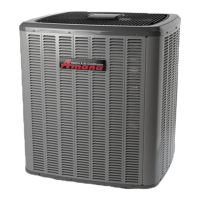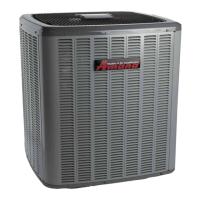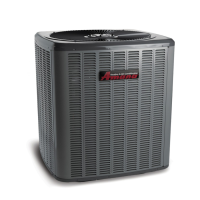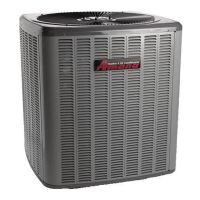SERVICING
9
1. Remove outer case, control panel cover, etc., from unit
being tested.
With power ON:
L
INE
V
OLTAGE
NOW
PRESENT
.
2. Using a voltmeter, measure the voltage across terminals
L1 and L2 of the contactor for the heat pump condens-
er unit or at the eld connections for the air handler or
heaters.
Measure the voltage across the L1 and L2 lugs on the
unitary (UC) control.
3. No reading - indicates open wiring, open fuse(s) no pow-
er or etc., from unit to fused disconnect service. Repair
as needed.
4. With ample voltage at line voltage connectors, energize
the unit.
Vol tage Min. Max
208/230 197 253
NOTE: When operating electric heaters on voltages other
than 240 volt, refer to the System Operation section on
electric heaters to calculate temperature rise and air ow.
Low voltage may cause insucient heating.
HIGH VOLTAGE !
DISCONNECT ALL POWER BEFORE SERVICING OR
INSTALLING. MULTIPLE POWER SOURCES MAY BE
PRESENT. FAILURE TO DO SO MAY CAUSE PROPERTY
DAMAGE, PERSONAL INJURY
OR DEATH.
1. Check wiring visually for signs of overheating, damaged
insulation and loose connections.
2. Use an ohmmeter to check continuity of any suspected
open wires.
3. If any wires must be replaced, replace with comparable
gauge and insulation thickness.
ComfortNet™ Ready Models
Communicating Thermostat Wiring: The maximum wire
length for 18 AWG thermostat wire is 250 feet.
L
INE
V
OLTAGE
NOW
PRESENT
.
With power ON, thermostat calling for cooling/heating.
1. Use a voltmeter to check for 24 volt at thermostat wires
C and R in the indoor unit control panel.
2. No voltage indicates trouble in the thermostat, wiring or
transformer source.
3. Check the continuity of the thermostat and wiring. Re-
pair or replace as necessary.
L
INE
V
OLTAGE
NOW
PRESENT
.
Resistance Heaters
With power ON:
1. Set room thermostat to a higher setting than room
temperature so both stages call for heat.
2. With voltmeter, check for 24 volt at each heater relay.
3. No voltage indicates the trouble is in the thermostat or
wiring.
4. Check the continuity of the thermostat and wiring.
Repair or replace as necessary.
NOTE: Consideration must be given to how the heaters
are wired (O.D.T. and etc.). Also safety devices must be
checked for continuity.
HIGH VOLTAGE !
DISCONNECT ALL POWER BEFORE SERVICING OR
INSTALLING. MULTIPLE POWER SOURCES MAY BE
PRESENT. FAILURE TO DO SO MAY CAUSE PROPERTY
DAMAGE, PERSONAL INJURY OR DEATH.
A step-down transformer (208/230 volt primary to 24 volt
secondary) is provided with each indoor unit. This al-
lows ample capacity for use with resistance heaters. The
outdoor sections do not contain a transformer (see note
below). (see indoor unit WIRING DIAGRAM)
DISCONNECT ALL POWER BEFORE SERVICING.
1. Remove control panel cover, or etc., to gain access to
transformer.
With power ON:
L
INE
V
OLTAGE
NOW
PRESENT
.
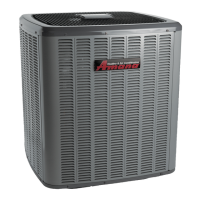
